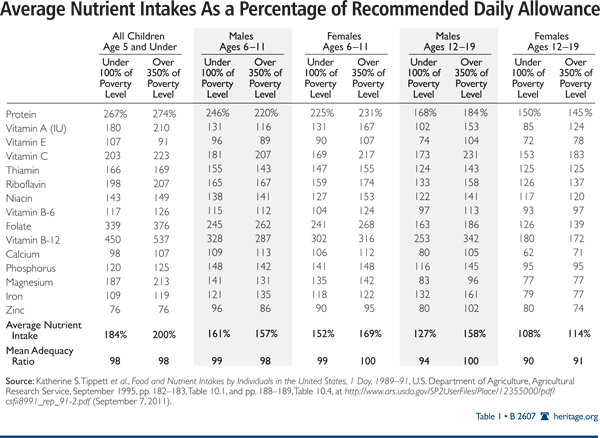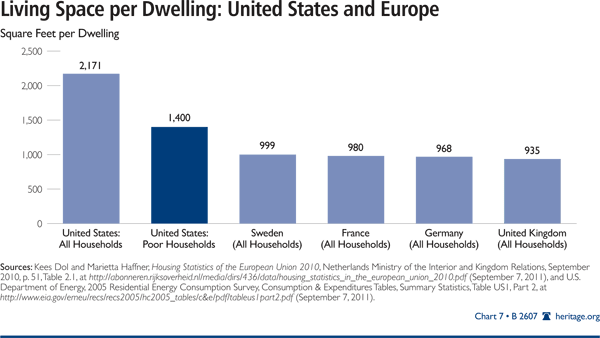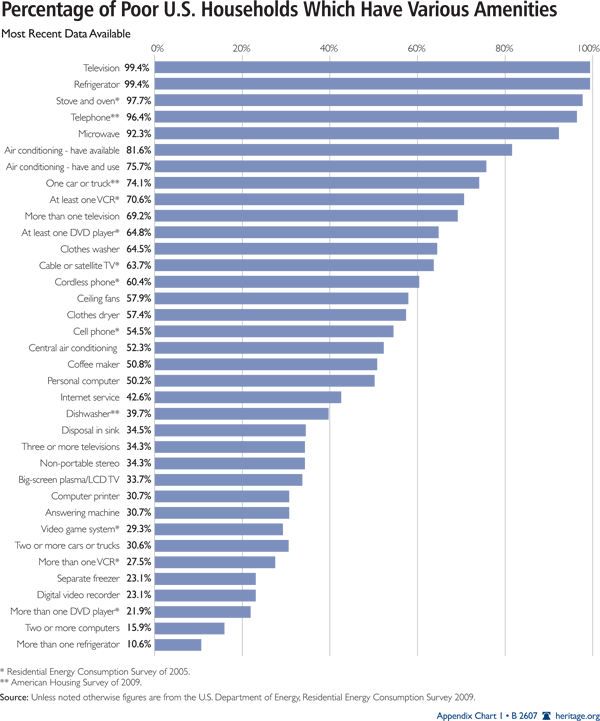Executive Summary
Today, the Census Bureau released its annual poverty report, which declared that a record 46.2 million persons, or roughly one in seven Americans, were poor in 2010. The numbers were up sharply from the previous year’s total of 43.6 million. Although the current recession has increased the numbers of the poor, high levels of poverty predate the recession. In most years for the past two decades, the Census Bureau has declared that at least 35 million Americans lived in poverty.
However, understanding poverty in America requires looking behind these numbers at the actual living conditions of the individuals the government deems to be poor. For most Americans, the word “poverty” suggests near destitution: an inability to provide nutritious food, clothing, and reasonable shelter for one’s family. However, only a small number of the 46 million persons classified as “poor” by the Census Bureau fit that description. While real material hardship certainly does occur, it is limited in scope and severity.
The following are facts about persons defined as “poor” by the Census Bureau as taken from various government reports:
- 80 percent of poor households have air conditioning. In 1970, only 36 percent of the entire U.S. population enjoyed air conditioning.
- 92 percent of poor households have a microwave.
- Nearly three-fourths have a car or truck, and 31 percent have two or more cars or trucks.
- Nearly two-thirds have cable or satellite TV.
- Two-thirds have at least one DVD player, and 70 percent have a VCR.
- Half have a personal computer, and one in seven have two or more computers.
- More than half of poor families with children have a video game system, such as an Xbox or PlayStation.
- 43 percent have Internet access.
- One-third have a wide-screen plasma or LCD TV.
- One-fourth have a digital video recorder system, such as a TiVo.
For decades, the living conditions of the poor have steadily improved. Consumer items that were luxuries or significant purchases for the middle class a few decades ago have become commonplace in poor households, partially because of the normal downward price trend that follows introduction of a new product.
Liberals use the declining relative prices of many amenities to argue that it is no big deal that poor households have air conditioning, computers, cable TV, and wide-screen TV. They contend, polemically, that even though most poor families may have a house full of modern conveniences, the average poor family still suffers from substantial deprivation in basic needs, such as food and housing. In reality, this is just not true.
Although the mainstream media broadcast alarming stories about widespread and severe hunger in the nation, in reality, most of the poor do not experience hunger or food shortages. The U.S. Department of Agriculture collects data on these topics in its household food security survey. For 2009, the survey showed:
- 96 percent of poor parents stated that their children were never hungry at any time during the year because they could not afford food.
- 83 percent of poor families reported having enough food to eat.
- 82 percent of poor adults reported never being hungry at any time in the prior year due to lack of money for food.
Other government surveys show that the average consumption of protein, vitamins, and minerals is virtually the same for poor and middle-class children and is well above recommended norms in most cases.
Television newscasts about poverty in America generally portray the poor as homeless people or as a destitute family living in an overcrowded, dilapidated trailer. In fact, however:
- Over the course of a year, 4 percent of poor persons become temporarily homeless.
- Only 9.5 percent of the poor live in mobile homes or trailers, 49.5 percent live in separate single-family houses or townhouses, and 40 percent live in apartments.
- 42 percent of poor households actually own their own homes.
- Only 6 percent of poor households are overcrowded. More than two-thirds have more than two rooms per person.
- The average poor American has more living space than the typical non-poor person in Sweden, France, or the United Kingdom.
- The vast majority of the homes or apartments of the poor are in good repair.
By their own reports, the average poor person had sufficient funds to meet all essential needs and to obtain medical care for family members throughout the year whenever needed.
Of course, poor Americans do not live in the lap of luxury. The poor clearly struggle to make ends meet, but they are generally struggling to pay for cable TV, air conditioning, and a car, as well as for food on the table. The average poor person is far from affluent, but his lifestyle is far from the images of stark deprivation purveyed equally by advocacy groups and the media.
The fact that the average poor household has many modern conveniences and experiences no substantial hardships does not mean that no families face hardships. As noted, the overwhelming majority of the poor are well housed and not overcrowded, but one in 25 will become temporarily homeless during the year. While most of the poor have a sufficient and fairly steady supply of food, one in five poor adults will experience temporary food shortages and hunger at some point in a year.
The poor man who has lost his home or suffers intermittent hunger will find no consolation in the fact that his condition occurs infrequently in American society. His hardships are real and must be an important concern for policymakers. Nonetheless, anti-poverty policy needs to be based on accurate information. Gross exaggeration of the extent and severity of hardships in America will not benefit society, the taxpayers, or the poor.
Finally, welfare policy needs to address the causes of poverty, not merely the symptoms. Among families with children, the collapse of marriage and erosion of the work ethic are the principal long-term causes of poverty. When the recession ends, welfare policy must require able-bodied recipients to work or prepare for work as a condition of receiving aid. It should also strengthen marriage in low-income communities rather than ignore and penalize it.
— Robert Rector is Senior Research Fellow in the Domestic Policy Studies Department, and Rachel Sheffield is a Research Assistant in the Richard and Helen DeVos Center for Religion and Civil Society, at The Heritage Foundation.
Understanding Poverty in the United States: Surprising Facts About America's Poor
Abstract: The Census Bureau’s annual poverty report presents a misleading picture of poverty in the United States. Few of the 46.2 million people identified by the Census Bureau as being “in poverty” are what most Americans would consider poor—lacking nutritious food, adequate warm housing, or clothing. The typical “poor” American lives in an air-conditioned house or apartment and has cable TV, a car, multiple color TVs, a DVD player, and a VCR among other conveniences. While some of the poor face significant material hardship, formulating a sound, long-term anti-poverty policy that addresses the causes as well as the symptoms of poverty will require honest and accurate information. Exaggerating the extent and severity of hardships will not benefit society, the taxpayers, or the poor.
Today, the Census Bureau released its annual poverty report, which declared that 46.2 million, or roughly one in seven Americans were poor in 2010.[1] The numbers were up sharply from the previous year’s total of 43.6 million. Although the current recession has increased the numbers of the poor, high levels of poverty predate the recession. In most years for the past two decades, the Census Bureau has declared that at least 35 million Americans lived in poverty.
Yet what do these numbers actually mean? What does it mean to be poor in America? For most Americans, the word “poverty” suggests near destitution: an inability to provide nutritious food, clothing, or reasonable shelter for one’s family. For example, the Poverty Pulse poll by the Catholic Campaign for Human Development in 2005 asked the general public: “How would you describe being poor in the U.S.?” The overwhelming majority of responses focused on homelessness, hunger or not being able to eat properly, and not being able to meet basic needs.[2] Yet if poverty means lacking nutritious food, adequate warm housing, and clothing, relatively few of the 46 million people identified by the Census Bureau as being “in poverty” could be characterized as poor.
The Census Bureau’s poverty report is widely publicized by the press. Regrettably, the report provides only a bare count of the number of Americans defined as poor by the government. It provides no data on or description of their actual living conditions. However, several other federal surveys provide detailed information on the living conditions of the poor.[3] These surveys provide a very different sense of American poverty. They reveal that the actual standard of living of America’s poor—in terms of amenities in the home, housing, food consumption, and nutrition—is far higher than expected.
These surveys show that most people whom the government defines as “in poverty” are not actually poor in any ordinary sense of the term. While material hardship does exist in the United States, it is restricted in scope and severity. Regrettably, the mainstream press rarely reports on these detailed surveys of living conditions.
Amenities in Poor Households
Chart 1 shows ownership of property and consumer durables among poor households based on data from the 2009 American Housing Survey,[4] which was conducted by the U.S. Department of Housing and Urban Development and the Census Bureau, and the 2009 Residential Energy Consumption Survey, which was conducted by the U.S. Department of Energy.[5] These surveys show that:
- 80 percent of poor households have air conditioning. By contrast, in 1970, only 36 percent of the U.S. population enjoyed air conditioning.
- 92 percent of poor households have a microwave.
- Nearly three-fourths have a car or truck, and 31 percent have two or more cars or trucks.
- Nearly two-thirds have cable or satellite TV.
- Two-thirds have at least one DVD player, and 70 percent have a VCR.
- Half have a personal computer, and one in seven have two or more computers.
- More than half of poor families with children have a video game system, such as an Xbox or PlayStation.
- 43 percent have Internet service.
- 40 percent have an automatic dishwasher.
- One-third have a wide-screen plasma or LCD TV.
- Around one-fourth have a digital video recorder, such as a TiVo.
- More than half have a cell phone.
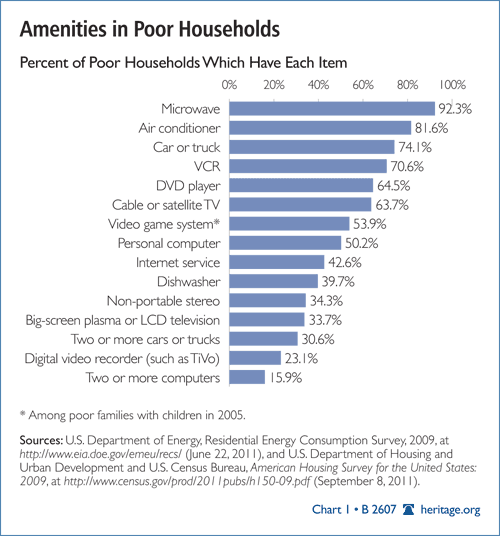
Of course, nearly all poor households have commonplace amenities such as color TVs, telephones, and kitchens equipped with an oven, stove, and refrigerator.
In 2005, more than half of poor households had at least five of the following 10 conveniences: a computer, cable or satellite TV, air conditioning, Internet service, a large-screen TV, non-portable stereo, computer printer, separate freezer or second refrigerator, microwave, and at least one color TV. One-fourth of the poor had seven or more of these 10 items in their homes. (See Chart 2.)
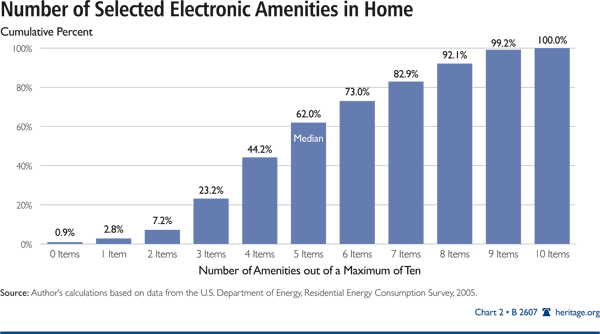
The exact combination of these 10 amenities obviously varied from one poor household to the next. Median or average poor households (five of 10 amenities) most commonly had air conditioning, cable TV, a stereo, microwave, and at least one TV.
Since 2005, the share of poor households having air conditioning, computers, wide-screen TVs, Internet service, and microwaves has increased significantly. Today, it is likely that a majority of poor households have at least six of the 10 items.
Steady Improvement in Living Conditions
Are the numbers in Chart 1 a fluke? Have they been inflated by working-class families with lots of conveniences in the home who have lost jobs in the recession and temporarily joined the ranks of the poor? No. The data indicate that the broad array of modern conveniences in the homes of the poor is the result of decades of steady progress in the living standards of the poor. Year by year, the poor tend to be better off. Consumer items that were luxuries or significant purchases for the middle class a few decades ago have become commonplace in poor households.
In part, this is caused by a normal downward trend in prices after a new product is introduced. Initially, new products tend to be expensive and therefore available only to the affluent. Over time, prices fall sharply, and the product saturates the entire population including poor households. As a rule of thumb, poor households tend to obtain modern conveniences about a dozen years after the middle class. Today, most poor families have conveniences that were major purchases or unaffordable to the middle class not too long ago.
Liberals use the declining relative prices of many amenities to argue that it is no big deal that poor households have air conditioning, computers, and cable TV. They contend that even though most poor families have houses full of modern conveniences, the average poor family still suffers from serious deprivation in basic needs, such as food, nutrition, and housing.[6] While such an outcome is theoretically possible, this paper demonstrates that this is not the case. In fact, the overwhelming majority of poor households have an adequate and reasonably steady supply of food, are not hungry, and are well housed.
Poverty and Malnutrition
Malnutrition (also called undernutrition) is a condition of reduced health due to a chronic shortage of calories and nutriments. There is little or no evidence of poverty-induced malnutrition in the United States. It is often believed that a lack of financial resources forces poor people to eat low-quality diets that are deficient in nutriments and high in fat, but survey data show that nutriment density (amount of vitamins, minerals, and protein per kilocalorie of food) does not vary by income class.[7] Nor do the poor consume higher-fat diets than do members of the middle class. The percentage of persons with high fat intake (as a share of total calories) is virtually the same for low-income and upper-middle-income persons.[8] However, overconsumption of calories is a major problem among the poor, as it is in the general U.S. population.
Examination of the average nutriment consumption of Americans reveals that age and gender play a far greater role than income class in determining nutritional intake. For example, the nutriment intakes of adult women in the upper middle class (incomes above 350 percent of the poverty level—roughly $76,000 for a family of four in today’s dollars) more closely resemble the intakes of poor women than those of upper-middle-class men, children, or teens.[9] The average nutriment consumption of upper-middle-income preschoolers is virtually identical with that of poor preschoolers, but not with the consumption of adults or older children in the upper middle class.
This same pattern holds for adult males, teens, and most other age and gender groups. In general, children who are 0–11 years old have the highest average level of nutriment intakes relative to the recommended daily allowance (RDA), followed by adult and teen males. Adult and teen females have the lowest level of intakes. This pattern holds for all income classes.
Nutrition and Poor Children. Government surveys provide little evidence of widespread undernutrition among poor children. In fact, they show that the average nutriment consumption among the poor closely resembles consumption among the upper middle class. Children in families with incomes below the poverty level actually consume more meat than do children in upper-middle-class families.
Table 1 shows the average intake of protein, vitamins, and minerals as a percentage of the RDA among poor and middle-class children at various age levels.[10] The intake of nutriments is very similar for poor and middle-class children and is generally well above the recommended daily level. For example, the consumption of protein (a relatively expensive nutriment) among poor children averages between 150 percent and 267 percent of the RDA.
When shortfalls of specific vitamins and minerals appear (for example, among teenage girls), they tend to be very similar for the poor and the middle class. While poor teenage girls, on average, tend to underconsume vitamin E, vitamin B-6, calcium, phosphorus, magnesium, iron, and zinc, a virtually identical underconsumption of these same nutriments appears among upper-middle-class girls. Along these lines, the USDA reports that there is no difference in diet quality between high and low-income children as measured by its healthy eating index.[11]
Poor Children’s Weight and Stature. On average, poor children are very well nourished, and there is no evidence of widespread significant undernutrition. For example, two indicators of undernutrition among the young are “thinness” (low weight for height) and stuntedness (low height for age). These problems are rare to nonexistent among poor American children.
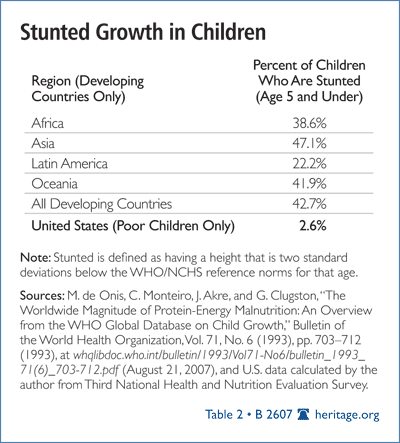
The generally good health of poor American children can be illustrated by international comparisons. Table 2 provides data on children’s size based on the World Health Organization (WHO) Global Data Base on Child Growth: Children are judged to be short or “stunted” if their height falls below the 2.3 percentile level of standard height-to-age tables.[12] Table 2 shows the percentage of children under five years of age in developing nations who are judged to be “stunted” by this standard.
In developing nations, some 43 percent of children are stunted. In Africa, more than one-third of young children are affected; in Asia, nearly half.[13] By contrast, in the United States, some 2.6 percent of young children in poor households are stunted by a comparable standard—a rate only slightly above the expected standard for healthy, well-nourished children.[14] While concern for the well-being of poor American children is always prudent, the data underscore how large and well-nourished poor American children are by global standards.
Throughout this century, improvements in nutrition and health have led to increases in the growth rate and the ultimate height and weight of American children. Poor children have clearly benefited from this trend. Today, poor boys at ages 18 and 19 are actually taller and heavier than boys of similar age in the general U.S. population in the late 1950s. They are one inch taller and some 10 pounds heavier than GIs of similar age during World War II and nearly two inches taller and 20 pounds heavier than American doughboys back in World War I.[15]
Poverty and Consistency of Food Supply
Most poor Americans are not undernourished, but experience an abundance of food over time rather than chronic shortfalls of food. However, even though the poor generally have an ample food supply, some do suffer from temporary food shortages. For example, even if a poor household has an adequate or good overall food supply when measured over a moderate period, it still might need to cut back meals or go without if food stamps run out at the end of the month. This problem of temporary food shortages leads some advocates to claim that there is widespread “hunger” in the United States.[16]
The current deep recession and prolonged high levels of unemployment have made it much more difficult for families to have a steady supply of food. Many families have been forced to eat less expensive food than they are accustomed to eating. Nonetheless, USDA survey data show that most households, poor or non-poor, do not suffer even temporarily from food shortages.[17] As Chart 3 shows, during the recession in 2009, 95 percent of all U.S. households report that they had “enough food to eat,” although not always the kinds of food that they would have preferred. Some 3.9 percent of all households report they “sometimes” did not have enough food to eat, while 1 percent said they “often” did not have enough food.[18]
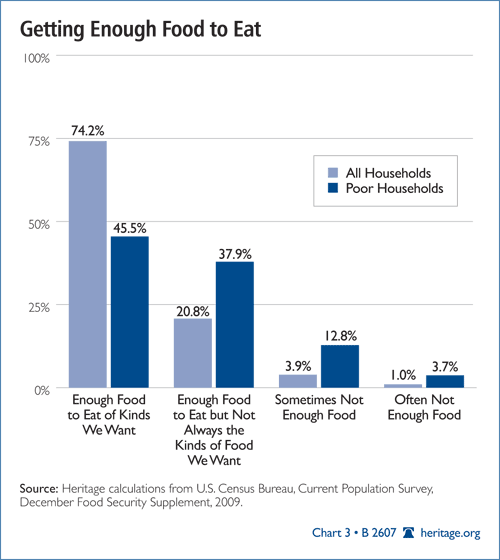
Among the poor, the figures are slightly lower: 83.4 percent of poor households asserted that they always had “enough food to eat,” although a full 38 percent of these did not always have the foods they would have preferred. Some 13 percent of poor households stated that they “sometimes” did not have enough food, and 3.7 percent said that they “often” did not have enough food.[19] The bottom line is that, although a significant portion of poor households do report temporary food shortages, five out of six poor households stated that they had enough food to eat even in the middle of a recession.
Poverty and Temporary Food Shortages. The USDA also measures temporary food shortages within households, a condition it calls “very low food security.”[20] According to the USDA, in households with very low food security, the “eating patterns of one or more household members were disrupted and their food intake reduced, at least some time during the year, because they couldn’t afford enough food.”[21]
At times, these households worried that food would run out, ate unbalanced meals, and relied on cheaper foods. In addition, adults usually cut back on the size of their meals or skipped meals to save money. In a majority of these households, adults reported feeling hungry at times but not eating due to a lack of food.[22] In the overwhelming majority of households with very low food security, adults ate less while shielding children from reductions in food intake.
Very low food security is almost always an intermittent and episodic problem for families rather than a chronic condition. The average family with very low food security experienced disrupted food intakes in seven months of the year, for one to seven days per month.[23]
As Chart 4 shows, roughly one in five poor households (18.5 percent) experienced very low food security or temporary disruptions and reductions in normal food intake in at least one month during 2009.[24] At some point during the same period, 3.9 percent of poor children also experienced very low food security.[25] Put in other terms, even during a severe recession, four out of five poor households and 96 percent of poor children did not experience any significant reductions or disruptions of food intake during the year.
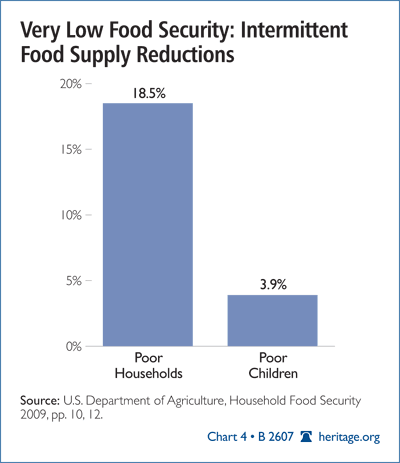
Poverty and Hunger. The USDA also asks specific questions about being “hungry.” (See Chart 5.) For example, in 2009, the USDA asked poor adults: “In the last 12 months, were you ever hungry, but didn’t eat, because there wasn’t enough money for food?” Even in the middle of a severe recession, 82 percent of poor adults reported they were never hungry at any time in the prior year due to lack of money to buy food.[26]
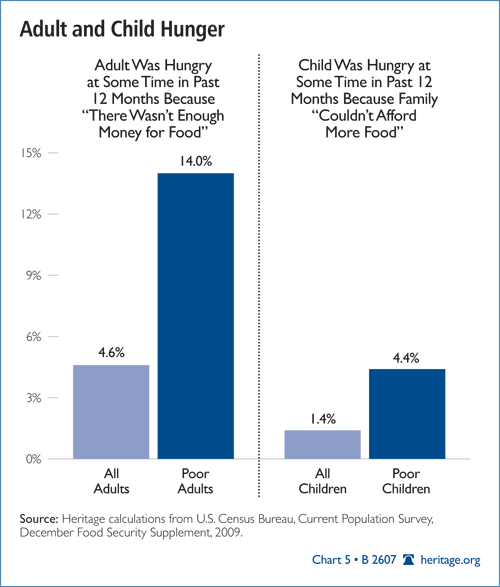
In 2009, the USDA also asked parents living in poverty the following question about their children: “In the last 12 months, were the children ever hungry but you just couldn’t afford more food?” Some 96 percent of poor parents responded that their children had never been hungry during the previous year due to a lack of food resources. Only 4 percent of poor parents responded that their children had been hungry at some point in the year.[27]
Poverty and Homelessness
The mainstream press and activist groups frequently conflate poverty with homelessness. News stories about poverty often feature homeless families living “on the street.”[28] This depiction is seriously misleading because only a small portion of persons “living in poverty” will become homeless over the course of a year. The overwhelming majority of the poor reside throughout the year in non-crowded housing that is in good repair.
The 2009 Annual Homeless Assessment Report to Congress published by the U.S. Department of Housing and Urban Development (HUD) states that on a given night in 2009, some 643,000 persons in the U.S. were homeless (without permanent domicile).[29] This means that at any given time, one out of 470 persons in the general population or one out of 70 persons with incomes below the poverty level was homeless.[30]
Moreover, two-thirds of the 643,000 homeless persons were residing in emergency shelters or transitional housing. Only 240,000 were without shelter; these “unsheltered” individuals were “on the street,” meaning that they were living in cars, abandoned buildings, alleyways, parks, or similar places.[31] At any point in 2009, roughly one person out of 1,250 in the general population or one out of 180 poor persons was homeless in the literal sense of being on the street and without shelter.
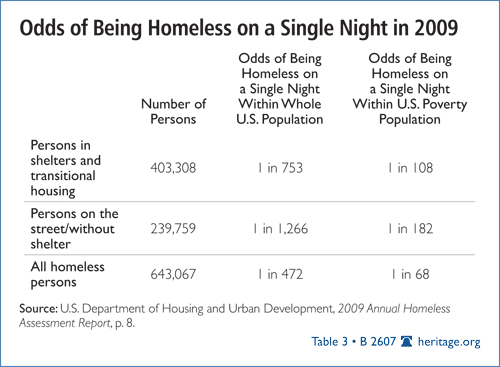
Homelessness is usually a transitional condition. Individuals typically lose housing, reside in an emergency shelter for a few weeks or months, and then reenter permanent housing. The transitional nature of homelessness means that many more people become temporarily homeless over the course of a year than are homeless at any single point in time. Thus, HUD reports that 1.56 million persons resided in an emergency shelter or transitional housing at least one night during 2009.[32] The year-round total of individuals who ever stayed in a shelter or transitional housing was nearly four times larger than the 403,000 who resided in such facilities on an average night.[33]
Based on the year-round data on shelter use, roughly one person in 195 in the general population resided in an emergency shelter or transitional housing for at least one night during a full 12-month period. Roughly one in 25 poor persons (4 percent of all poor persons) resided in an emergency shelter or transitional housing for at least one night during the full year.[34]
Although news stories often suggest that poverty and homelessness are similar, this is inaccurate. In reality, the gap between the living conditions of a homeless person and the typical poor household are proportionately as great as the gap between the poor household and a middle-class family in the suburbs.
Housing Conditions and Poverty
When the mainstream media do not portray the poor as homeless, they will often present them as living in dismal conditions such as an overcrowded, dilapidated trailer. Again, government survey data provide a very different picture. Most poor Americans live in conventional houses or apartments that are in good repair. As Chart 6 shows, 49.5 percent of poor households live in single-family homes, either unattached single dwellings or attached units such as townhouses. Another 41 percent live in apartments, and 9.5 percent live in mobile homes.[35]
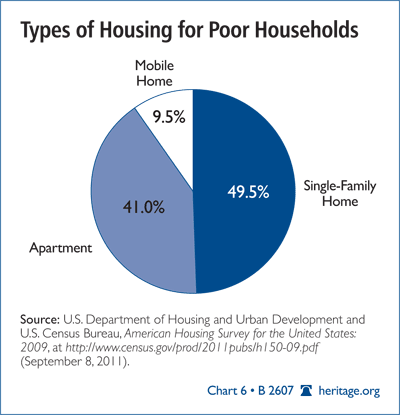
Poverty and Crowding. Both the overall U.S. population and the poor in America live in very spacious housing. As Table 4 shows, 71 percent of all U.S. households have two or more rooms per tenant. Among the poor, this figure is 65 percent.
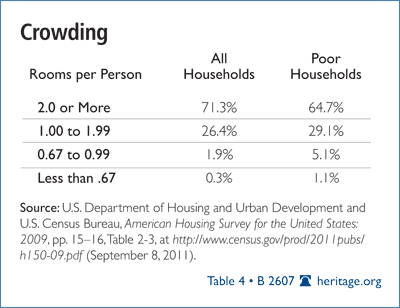
Crowding is quite rare. Only 2.2 percent of all households and 6.2 percent of poor households are crowded with less than one room per person.[36] By contrast, social reformer Jacob Riis, writing on tenement living conditions around 1890 in New York City, described crowded families living with four or five persons per room and some 20 square feet of living space per person.[37]
Living Space: Europe Versus the United States. Another way of measuring living space is the square footage of a dwelling. As Chart 6 and Table 5 show, U.S. houses and apartments are, on average, much larger than their European counterparts. With 2,171 square feet of living space, the average U.S. dwelling is more than twice the size of the average dwelling in Europe, including those in highly developed economies, such as Sweden (999 square feet); France (980 square feet); Germany (968 square feet); and the United Kingdom (935 square feet).[38] Dividing the total living space of a dwelling by the number of persons living there yields living space per person. By this measure, the average U.S. household has more than twice the living space of the average European household.
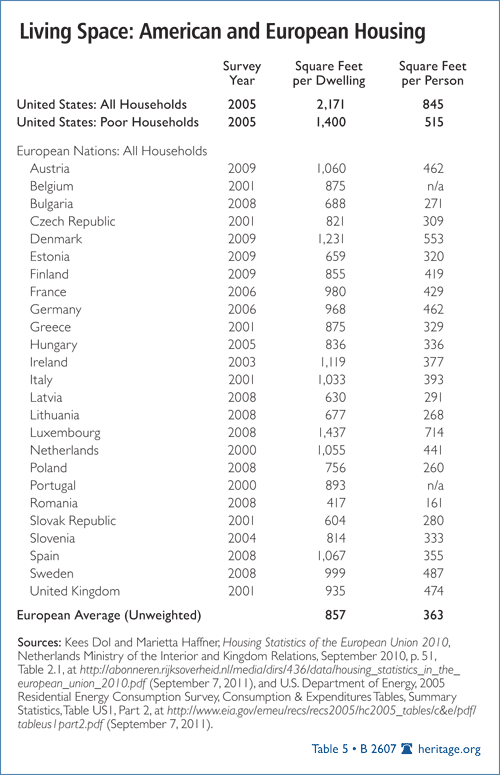
Living Space: Europeans Versus Poor Americans. As Chart 7 and Table 5 show, on average, the dwellings of poor Americans are about two-thirds the size of the average U.S. dwelling. Nonetheless, at 1,400 square feet, the dwelling of the average poor American is still substantially larger than the average dwelling in every European nation except Luxembourg. For example, the average dwelling of poor Americans is 40 percent larger than the average dwelling unit in Sweden (999 square feet). (This comparison is between poor Americans and the average citizen in the whole population within each European nation, not poor Europeans.)
Poor American households tend to have somewhat more people on average than do European households; nonetheless, as Table 5 shows, at 515 square feet per person, the average poor American has more living space than the average citizen—not just the poor—in every European nation except Luxembourg and Denmark.
Poverty and Home Ownership. The American Housing Survey reports that roughly 41 percent of poor households owned their own homes. The average home owned by persons classified as poor by the Census Bureau is a three-bedroom house with one-and-a-half baths, a garage, and a porch or patio. The median value of homes owned by poor households was $100,000 in 2009, or 60 percent of the median value of all homes owned in the United States.[39]
The remaining poor households lived in rental housing. As Chart 8 shows, roughly one-fifth of all poor households lived in government-subsidized rental housing. Around 41 percent lived in rented apartments or houses without government assistance.[40]
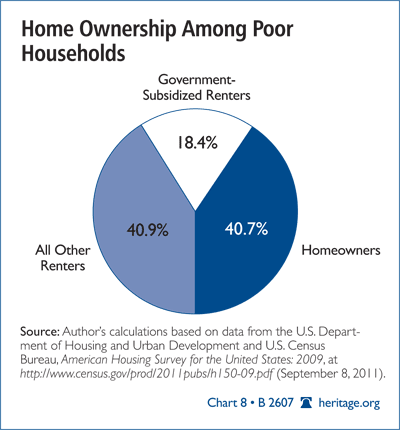
Housing Quality. Of course, the housing of poor American households could be spacious but still dilapidated or unsafe. However, the American Housing Survey indicates otherwise. For example, the survey reports that only a small portion of poor households (3.1 percent) and an even smaller portion of total households (1.7 percent) have “severe physical problems.” The most common severe problem is a shared bathroom, which occurs when occupants lack a private bathroom and must share bathroom facilities with individuals in a neighboring unit. This condition affects about 1 percent of all U.S. households and 1.4 percent of all poor households. About 1 percent of all households and 2 percent of poor households have other “severe physical problems.” The most common is repeated heating breakdowns.[41]
The American Housing Survey also indicates that 6.8 percent of the poor and 3.5 percent of total households have “moderate physical problems.” The most common moderate physical problems are upkeep problems, lack of a full kitchen, and use of unvented oil, kerosene, or gas heaters as the primary heat source.[42]
Essential Needs. Although the public equates poverty with physical deprivation, the overwhelming majority of poor households do not experience any form of physical deprivation. Some 70 percent of poor households report that during the course of the past year, they were able to meet “all essential expenses,” including mortgage, rent, utility bills, and important medical care. Although it is widely supposed that the poor cannot obtain medical care, only 13 percent of poor households report that a family member needed to go to a doctor or hospital at some point in the prior year but was unable to do so because the family could not afford the cost.[43]
Public Understanding of Poverty
In 2005, the typical poor household, as defined by the federal government, had air conditioning and a car. For entertainment, the household had two color TVs, cable or satellite TV, a DVD player, and a VCR. In the kitchen, it had a refrigerator, an oven and stove, and a microwave. Other household conveniences included a clothes washer, clothes dryer, ceiling fans, a cordless phone, and a coffee maker. The family was able to obtain medical care when needed. Their home was not overcrowded and was in good repair. By its own report, the family was not hungry and had sufficient funds during the past year to meet all essential needs.[44]
The overwhelming majority of Americans do not regard a family living in these conditions as poor. For example, a poll conducted in June 2009 asked a nationally representative sample of the public whether they agreed or disagreed with the following statement: “A family in the U.S. that has a decent, un-crowded house or apartment to live in, ample food to eat, access to medical care, a car, cable TV, air conditioning and a microwave at home should not be considered poor.”[45] A full 80 percent of Republicans and 77 percent of Democrats agreed that a family living in those living conditions should not be considered poor.
Census Poverty Reports: Misleading and Inaccurate
Nonetheless, each year, the Census Bureau issues a report claiming that more than 35 million Americans live in poverty. The annual report is flawed in two respects.
First, it provides no information on the actual living conditions of the persons identified as poor. It simply states that a specified number of persons are poor without giving any information on what poverty means in the real world. A detailed description of the living conditions of the poor would greatly enhance public understanding. In fact, without a detailed description of living conditions, public discussions of poverty are meaningless.
Second, the report massively undercounts the economic resources provided to poor people. The Census Bureau asserts that a household is poor if its “money income” falls below a specified threshold. In 2010, the poverty income threshold for a family of four was $22,314. However, in counting the money income of households, the Census Bureau excludes virtually all welfare assistance. For example, more than 70 means-tested welfare programs provide cash, food, housing, medical care, and social services to poor and low-income persons,[46] including Temporary Assistance for Needy Families (TANF), Supplemental Security Income (SSI), the Earned Income Tax Credit (EITC), food stamps, the Women, Infants, and Children (WIC) food program, public housing, and Medicaid. (Social Security and Medicare are not means-tested programs.)
In 2008, federal and state governments spent $714 billion on means-tested welfare programs, but the Census Bureau counted only about 4 percent of this as money income in determining whether a household was poor. The bottom line is that the economic resources available to poor persons are vastly greater than the report claims.
In fact, the U.S. Department of Labor finds that the one-fifth of households with the lowest incomes appear to spend $1.87 for every $1.00 of income that the Census Bureau says they receive. If the free medical care and public housing subsidies given to these households were counted, the gap between expenditure and income would be even greater.[47]
Was the War on Poverty a Success?
In 2010, government spent $871 billion on means-tested assistance. This amounts to nearly $9,000 for every poor and low-income American. Many “poor” families have higher-than-expected living standards because they receive considerable government aid that is “off the books” for purposes of measuring poverty. Do the higher living standards of the poor mean that the welfare state has been successful?
The answer is: yes and no. Not even the government can spend $9,000 per person without significantly affecting living conditions. However, the original goal of the War on Poverty was not to prop up living standards artificially through an ever-expanding welfare state. When Lyndon Johnson launched the War on Poverty, he intended it to strike “at the causes, not just the consequences of poverty.”[48] He added, “Our aim is not only to relieve the symptom of poverty, but to cure it and, above all, to prevent it.”[49]
President Johnson was not proposing a massive system of ever-increasing welfare benefits doled out to an ever-growing population of beneficiaries. His proclaimed goal was not to create a massive new system of government handouts, but to increase self-sufficiency in a new generation, enabling them to lift themselves out of poverty without government handouts. LBJ planned to reduce, not increase, welfare dependence. The goal of the War on Poverty was “making taxpayers out of taxeaters.”[50] He declared, “We want to give the forgotten fifth of our people opportunity not doles.”[51]
The U.S has spent over $17 trillion on means-tested welfare since LBJ launched the War on Poverty. Over time, the material living conditions of the poor have improved. It would be impossible to spend $17 trillion without any positive impact on living conditions, but in terms of reducing the “causes” rather than the “consequences” of poverty, the War on Poverty has failed utterly. The situation has gotten worse, not better. A significant portion of the population is now less capable of prosperous self-sufficiency than they were when the War on Poverty began.
Addressing the Causes, Not Merely the Symptoms, of Poverty
A major element in the declining capacity for self-support is the collapse of marriage in low-income communities. As the War on Poverty expanded benefits, welfare began to serve as a substitute for a husband in the home, and low-income marriage began to disappear. When Johnson launched the War on Poverty, 7 percent of American children were born out of wedlock. Today, the number is over 40 percent. As married fathers disappeared from the home, the need for more welfare to support single mothers increased. The War on Poverty created a destructive feedback loop: Welfare undermined marriage, and this generated a need for more welfare.
Today, out-of-wedlock childbearing—with the resulting growth of single-parent homes—is the most important cause of child poverty. (Out-of-wedlock childbearing is not the same thing as teen pregnancy; the overwhelming majority of non-marital births occur to young adult women in their early twenties, not to teenagers in high school.) If poor women who give birth outside of marriage were married to the fathers of their children, two-thirds would immediately be lifted out of poverty.[52] Roughly 80 percent of all long-term poverty occurs in single-parent homes.
Despite the dominant role of the decline of marriage in child poverty, this issue is taboo in most anti-poverty discussions. The press rarely mentions out-of-wedlock childbearing. Far from reducing the main cause of child poverty, the welfare state cannot even acknowledge its existence.
The second major cause of child poverty is lack of parental work. Even in good economic times, the average poor family with children has only 800 hours of total parental work per year—the equivalent of one adult working 16 hours per week. The math is fairly simple: Little work equals little income, which equals poverty. If the amount of work performed by poor families with children was increased to the equivalent of one adult working full time throughout the year, the poverty rate among these families would drop by two-thirds.[53]
The welfare system needs to be transformed to further reduce child poverty and to promote prosperous self-sufficiency. When the current recession ends, able-bodied parents should be required to work or prepare for work as a condition of receiving aid. In addition, the welfare system should support and encourage, rather than penalize, marriage.
Conclusion
The living conditions of the poor as defined by the government bear little resemblance to notions of “poverty” promoted by politicians and political activists. If poverty is defined as lacking adequate nutritious food for one’s family, a reasonably warm and dry apartment, or a car to go to work when one is needed, then the United States has relatively few poor persons. Real material hardship does occur, but it is limited in scope and severity.
In 2005, the typical poor household as defined by the government had a car and air conditioning. For entertainment, the household had two color TVs, cable or satellite TV, a DVD player, and a VCR. If children—especially boys—were in the home, the family had a game system, such as an Xbox or PlayStation. In the kitchen, the household had a refrigerator, an oven and stove, and a microwave. Other household conveniences included a clothes washer, clothes dryer, ceiling fans, a cordless phone, and a coffee maker.[54]
The home of the typical poor family was not overcrowded and was in good repair. The family was able to obtain medical care when needed. By its own report, the family was not hungry and had sufficient funds during the previous year to meet all essential needs.
Poor families certainly struggle to make ends meet, but in most cases, they are struggling to pay for air conditioning and the cable TV bill as well as to put food on the table. While poor households certainly are not sitting in the lap of luxury, their actual living standards are far different from the images of dire deprivation promoted by activists and the mainstream media.
However, the average poor family does not represent every poor family. There is a range of living conditions within the poverty population. Although most poor families are well housed, a small minority are homeless.[55] Although most poor families are well fed and have a fairly stable food supply, a sizeable minority experiences temporary shortages in food supply at various times during the year.
Nonetheless, the living standards of most poor households are far different from what the public imagines and differ greatly from the images of dramatic hardship conveyed by advocacy groups and the mainstream media. Why, then, does the Census Bureau routinely report that over 35 million Americans live in poverty? Its annual poverty report is inaccurate and misleading in part because nearly all of the welfare state is excluded from its poverty calculations. The Census Bureau identifies a family as “poor” if its income falls below specific thresholds; however, in counting a family’s income, the Census Bureau omits nearly all welfare benefits. In 2010, government spent $871 billion on means-tested welfare programs that provided cash, food, housing, medical care, and social services to poor and low-income Americans.[56] Virtually none of this assistance is counted as income for purposes of the Census Bureau’s estimations of poverty or inequality.
In 2010, government means-tested assistance averaged nearly $9,000 for each poor and low-income American. Many “poor” families have higher than expected living standards in part because they receive considerable government aid that is “off the books” for purposes of counting poverty. Do the higher living standards of the poor mean that the welfare state has been successful?
The answer is: yes and no. Not even the government can spend $9,000 per person without having a significant effect on living conditions. But the original goal of the War on Poverty was not to prop up living standards artificially through an ever-expanding welfare state. President Lyndon Johnson intended for the War on Poverty to make Americans self-sufficient and prosperous through their own abilities, not through increased reliance on government aid. Ironically, Johnson actually planned to reduce, not increase, welfare dependence. His declared goal for the War on Poverty was “making taxpayers out of taxeaters.”[57]
Since the beginning of the War on Poverty, the U.S. has spent over $17 trillion on anti-poverty programs. In terms of its original goal of making poor Americans self-sufficient and prosperous through their own abilities, the War on Poverty has been a colossal failure. In many low-income communities, the work ethic has eroded and marriage has collapsed. As result, lower-income groups are less capable of self-sufficient prosperity today than they were when the War on Poverty began.
Congress should reorient the massive welfare state to promote self-sufficient prosperity rather than expanded dependence. As the recession ends, able-bodied recipients should be required to work or prepare for work as a condition of receiving aid. Even more important, the welfare system needs to abandon its 50-year-old tradition of ignoring, dismissing, and penalizing marriage. It should embark on a new course to strengthen and rebuild marriage in low-income communities.
— Robert Rector is Senior Research Fellow in the Domestic Policy Studies Department, and Rachel Sheffield is a Research Assistant in the Richard and Helen DeVos Center for Religion and Civil Society, at The Heritage Foundation.
